According to several religious traditions, reincarnation isn’t so much about what you want, but what you deserve. It might be tempting to curse your lot in life but ensuring a better tomorrow depends entirely on how you live today.
Title: カラフル (Colorful)
Original airing: Aug 21, 2010
Studio: Ascension
Director: Keiichi Hara
Duration: 2 hr. 7 min.
Genres: Slice of Life, Drama, Supernatural
Source: Karafuru Novel by Eto Mori
Where I watched: Blu-ray disc
Watch the trailer here (Japanese)
Brief Synopsis and First Impressions
There is a train station on the other side of death, yet not all who arrive on the platform will be judged ready for passage onwards. For one unready soul, there will be both a test and a second chance. Rather than be reborn, this soul will awake in the body of 14-year-old suicide Makoto Kobayashi where it must not only find a way to fit into Makoto’s existence, but also unravel two mysteries. What is the secret of the great sin it committed in its own previous life and what were the reasons that led to Makoto’s suicide? While some may believe the truth to be as plain to see as black and white, “Makoto” soon finds that the real world is overlaid with so many shades of grey and rainbows of colors that even the most obvious of “facts” are not what they seem.
Credit: Sentai Filmworks
Colorful was virtually a blind watch for me. I bought it as part of a sale that the licensor, Sentai Filmworks, was having and had very little to go by to gauge my personal interest. It sounded like a reincarnation story, albeit with a mystery element tied in, but otherwise had nothing immediately catching about its premise. What honestly convinced me to buy was the fact that it won the 34th Japanese Academy Prize for Excellence in Animation. Even without a high level of interest, it would probably still be a good film.
It’s been a while since my last review, which capped off my anime series challenge last year. This, however, is the first movie review I’ve written for this blog and have done my best to fit it into my standard format. That said, where my story sections normally takes up the bulk of the discussion, here it’s the characters that really drive the story and require more focus when discussing this film.
One thing to note to avoid confusion when reading this review: As the protagonist’s name is a unknown for most of the movie, I use Kobayashi to refer to the suicide victim, Makoto Kobayashi, while “Makoto” refers to the spirit that reincarnates into his body.
Story
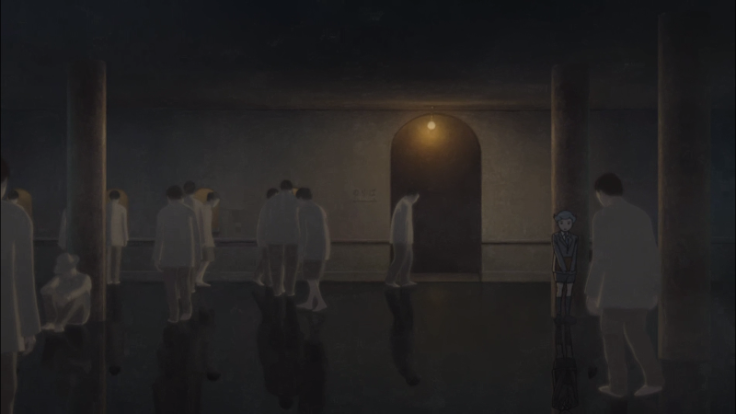
The film opens with what appears to be a transit station for departed souls heading to the afterlife. As each nondescript soul passes through, one is stopped by a being that looks like a young boy. The boy, calling himself Purapura, informs the soul that it’s won a lottery for a second chance and will be placed in the body of 14 year old suicide victim for another chance at life. Thinking Purapura to be an angel, the soul unwittingly agrees despite its strong desire of wanting to simply pass on.
Having the soul introduced from a first person view and referring to itself as “I” sets the perspective that is followed for the rest of the film. Though the first person view is dropped after the soul enters the body of the young boy, Makoto Kobayashi (hereafter Kobayashi), everything revealed to the viewer is seen from “Makoto’s” (the spirit inhabiting the body of the boy) point of view. This feels all the more appropriate considering the task given to the spirit – find out the reasons for Makoto’s suicide, as well as the grave sin it committed in its former life.
Clues are provided early on as to why the boy might have committed suicide when Purapura briefs “Makoto” on the life he’s inherited. A cold and distant older brother, a father that spends little time with the family, and a mother who had been in an affair with her dance instructor up until Kobayashi’s suicide round out his new family. With little going for Kobayashi outside of a talent for art, “Makoto” quickly grows dismayed by the lot he’s been given. Learning only that the severity of his past crime dictated the kind of life he would be given for his reformation attempt, “Makoto” wonders aloud just what he could have done to deserve this fate.

Despite the supernatural introduction and mystery element, the story plays out in a very grounded fashion, focusing on the encounters “Makoto” has as he tries to navigate his way through the unfamiliar life. In this fashion he proves to be the best window into the story as he is dropped into it with no more information than the viewer has. As a result the great majority of the film’s content is little more than a third person view, using his various interactions to frame the mindset that he develops toward his borrowed life.
It isn’t just “Makoto” that can draw interest in this story either. A number of other characters, most notably the parents but also other kids at school, approach him differently following the post-suicide hospitalization. Their behavior often feel counter to what he was led to expect from Purapura, such as increased attentiveness from his parents and a handful of students talking to him more at school. Nearly every one of these side characters has a compelling story of their own, with conflicting motivations that lead them to act the way they do.
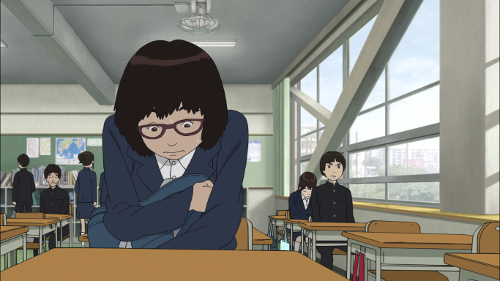
These perceived changes cause “Makoto” to also pursue avenues that would be otherwise outside his normal pattern of behavior. Feeling rebellious, carefree, and depressed by turns, “Makoto” becomes caught up in the life he’s supposed to be trying to understand before his time runs out. Still, this exploration builds upon the film’s theme of “colorful,” multifaceted personalities by highlighting the myriad emotions within himself and others.
Subtly building toward a finale with the various things “Makoto” goes through, the film does a decent job of keeping its secret until the end. Like “Makoto”, the viewer can become easily caught up by the lives unfolding around them and nearly lose sight of the goal presented in the beginning. Nevertheless, the ending pulls together most of the lessons the film imparts to provide a reasonable conclusion to both the mystery as well as the seemingly meandering narrative it presented.
Characters
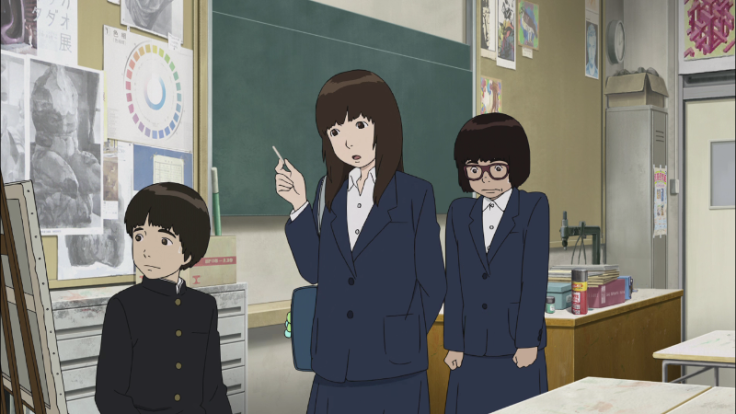
I mentioned earlier that the characters do the majority of driving in this story. Considering how little of the two hour runtime in Colorful is dedicated to the specifics of the mystery which begins the story, they end up taking on a more vital role. This is because what makes them compelling in the first place lies at the heart of what this film tries to convey.
The primary vehicle for this is “Makoto,” whose journey through life in the literal footsteps of the deceased boy provide the basis for exploring and understanding the other characters as well as most of the drama in the film’s events.
His first interactions reveal a caring and attentive family, aside from an emotionally distant brother, which leads him to regard them with respect and pleasantry. It’s only after their faults are explained to him that “Makoto” becomes embittered, taking the mother’s infidelity and the father’s neglect as personal slights which affect his behavior. Later on, after deciding to resume school, he develops an interest toward a girl that Kobayashi appeared to have a crush on.

In these ways, “Makoto” begins to take on same troubled teenager persona of the boy whose life he’s borrowed. Far from the objective and detached personality that might be needed to fulfill his goal, “Makoto” is flawed in his understanding of the world and prone to errors in judgement. With his former life a mystery to both himself and the viewer, he blends into his new one almost seamlessly. His struggle to figure himself out thus becomes an extension of the adolescent ordeal itself, with its twists and turns handled about as well as you might expect by a socially awkward teen.
“Makoto’s” first and most prevalent experiences involve Kobayashi’s parents, with whom he usually shares an awkward meal on most days. These two deserve a special mention if for nothing more than their persistence in dealing with “Makoto.” With their eyes apparently opened up by the incident with their son, both parents exercise a great deal of patience in the face of his rude behavior and go out of their way to reach out to him.
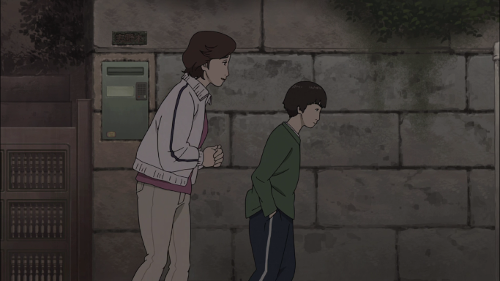
Seeing their constant efforts to appease their son, it’s difficult not to sympathize with the parents despite their previously exposed flaws. This could be because the audience never really sees the behaviors that Kobayashi despised about them, much less understands why they affect him so deeply. All the same, their genuine concern for their son’s happiness and well-being firmly frame them as characters working to make things right.
Some of the more interesting scenes take place between “Makoto” and the other kids at school, many of which hardly interacted with him before. Two girls, Hiroka and Shouko, in particular have a strong effect on his experience there, and especially during the time he spends in the art club. “Makoto” knows a seedy secret about Hiroka, and he quickly latches onto the girl’s friendly behavior. Conversely, the nosy and perpetually nervous Shouko earns his ire early on when she points out that Makoto has changed. Though “Makoto” cannot seem to stand her, she frequently, and awkwardly, approaches him to try to determine why he seems different.

These characters are meant to foil each other, both in the opinions “Makoto” forms about them as well as how they perceive themselves. Hiroka’s focus on her social life and outward appearance, and the lengths she goes to achieve it, contrasts Shouka’s disregard for both. Shouka also appears to be more introspective, attempting to interpret Makoto’s feelings even if they are negative where Hiroka displays a superficial and detached approach despite how socially adept she appears to be.
The only one with enough knowledge to keep “Makoto” on track is the mysterious Purapura. Friendly and enthusiastic at first, the strange spirit becomes angry and even aggressive when disrespected. While he acts with a maturity and certainty that contradicts his childlike appearance, his words frequently have a disconcerting tone. Irritable to the point of “Makoto” questioning if he’s an angel, Purapura nevertheless seems keenly interested in seeing him succeed at his task.

While more about his character would be appreciated, the mystery element of the film would have been dampened with earlier exposure. Furthermore, as the only character with knowledge of the situation, he doesn’t quite fit in with the others whose everyday life is wrought with trial and error in ways that help “Makoto” understand the lessons he was meant to learn as part of his reformation.
Animation

Judging by the cover art and the name, one might expect Colorful to be a vibrant display, playing off the word’s intent to convey the complex and multifaceted nature of people in a more literal sense. Instead, the color scheme for most of this film is much more washed out and drab. This isn’t to say that this is a bad thing though, as the muted hues do well to represent the heavier emotional tones that litter the film.
The character designs are simple for the most part, but work very well to express each character in a unique way. A brief glance reveals “Makoto’s” depression, his mother’s worried hopefulness, or his father’s gentle nature. Their expressiveness in even the smallest changes in emotion is noticeable without being exaggerated, and overall the characters feel very real in their depiction. Detail is generally very good, aside from scenes where the characters are further in the background or many of them appear on screen. Even in these cases though, the fluid animation fills in details when needed (eg: as they approach the camera).

Despite the less than striking visual style, the realistic animation still has a high level of quality. Backgrounds are mostly static, allowing them to portray the detail and ambiance of the setting in each scene. While the effect clashes with foreground characters initially it becomes less distracting the more you see it, and even these static images appear lifelike as they build upon the developing story. By using slight variations in style throughout the film they accent the shifting emotional landscape that “Makoto” navigates, adding an extra touch of brilliance in a subtle way.

In addition to this, much of the film’s storytelling is achieved through attentive shot composition. Simple things like focusing on “Makoto’s” shoes as he walks down the road provide context for important scenes that follow, and help build the atmosphere of a story that relies so heavily on the small details that influence “Makoto’s” thoughts. Framing much of what happens directly from his point of view also reinforces how dependent the viewer is on him to interpret the narrative.
Sound
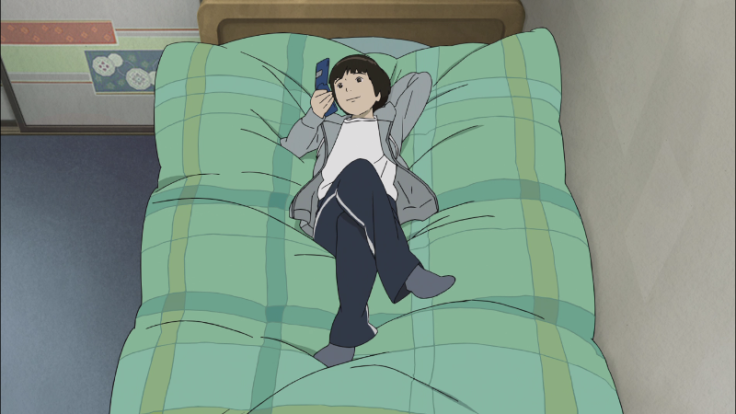
As is typical for its genre, Colorful features an instrumental soundtrack consisting mostly of strings and piano ensembles. Given the dour subject matter it’s also no surprise that several of the tracks from the OST are slow moving pieces that evoke a sadder tone with many being variations on what can be considered the “main” theme, Dare mo Inai. But like the people and feelings depicted in the movie, the music is far from one note as Sound Director Ko Otani (Another, Outlaw Star, Haibanei Renmei) provides a number of other tracks with no lack of emotional depth. Whether it’s quiet optimism in a track like Massugu Na Kimochi or a heavier electric guitar laden theme to accompany the dejection that “Makoto” feels, the music really helps drive the impact of each scene.
When considering the voice work, there are two ways to look at the approach in this film depending on your view of how expressive the characters should be. The Japanese voice work is generally serviceable, though nothing stands out as an overly impressive performance. The seiyuu cast has very little experience overall, with Colorful being the only title for some, which may be the reason for some of this. Still, Kazato Tomizawa (V.V. from Code Geass) does a rather good job portraying “Makoto’s” sullen attitude as well as the emotional shifts between his inner and spoken voice.
The blu-ray from Sentai contains an English dub which features much more distinctive voice work. Greg Ayres (Kaoru from Ouran High School Host Club) brings his unique voice to the lead role. His Ouran co-star Luci Christian also makes an appearance as Purapura, and sounds just as you might expect if you’re familiar with her Honey senpai role. Of note as well is Shouko’s actress, Brittany Karbowski (Wendy Marvell from Fairy Tail), in an anxiety ridden performance that seems to match her character’s twitchy behavior. In contrast her Japanese counterpart, Aoi Miyazaki (Hana from Wolf Children), has a far less spastic take on the role but still sounds convincingly nervous.
Overall Appeal
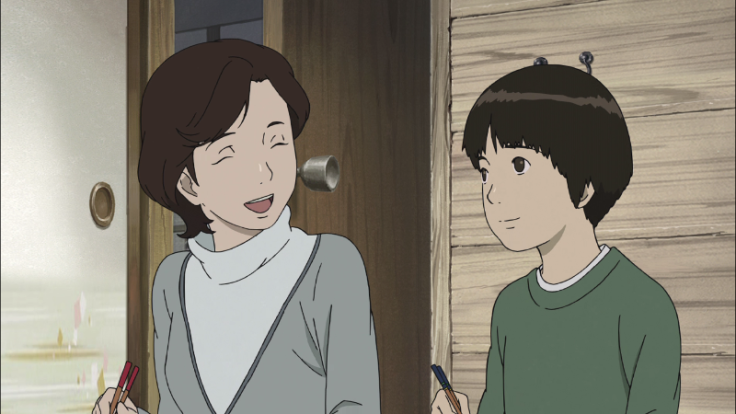
You might think Keiichi Hara an odd fit for this type of film if your most familiar with him from Crayon Shin-chan, as it’s easy to typecast someone who created ten films about a lewd mouthed problem child. Nevertheless, he has an aptitude for more emotionally driven work as can be seen with his previous film Summer Days with Coo and his more recent Sarusuberi: Miss Hokusai. With Colorful, Hara was able to turn “Makoto’s” journey of depression and self discovery into a compelling drama despite its slow pace and deceptive lack of focus.
With this journey being the crux of the film, a large part of enjoying it depends on how much interest the main character’s struggle draws. Depression and suicide can be a difficult topic to address, but the movie focuses on exploring what leads to these morose feelings in an effort to impart valuable lessons onto “Makoto.” The treatment seems one sided at first, using the character’s various faults to underline where his behavior brings pain to himself and those around him. These actions, however, ultimately reconcile his thoughts as he gains a better understanding of how complex people are.
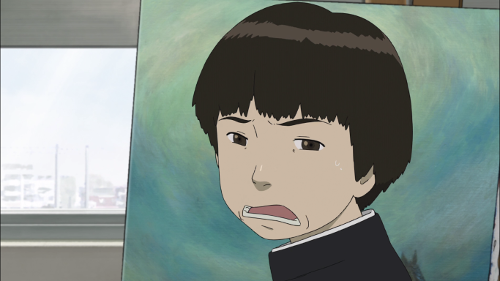
How any of this relates to “Makoto” understanding his own sin can be a frustrating puzzle at times as he tries to make the most of his second chance. But even as the film and the main character sideline this quest, his journey through Kobayashi’s life is interesting by itself. His family and the various other characters he interacts with have compelling stories of their own, with each one’s outlook and approach to life meant to impart a lesson for him. Unfortunately the film only provides the most brief look into them, placing the burden of engagement further on “Makoto.”
One of the ways in which it does this is through exploring Kobayashi’s art. After learning that he had some talent for it, “Makoto” takes part in the school’s art club where he has several meetings with Hiroka and Shouko. An unfinished painting of a horse against a blue/green backdrop is the main piece that he interacts with, even if he’s only just staring at it. Its meaning is not so vital as is the different ways the two girls interpret it. Their frequent discussions about and around the painting reveal the depth of their respective emotional empathy as well as “Makoto’s” own bias through his reactions. Later on, a sketchbook left in his room gives a surreal look into how Kobayashi’s feelings changed over time. These small touches go a long way in visually building the emotional state of the character without the need for explicit exposition.

For all the subtlety employed in driving “Makoto’s” arc, however, the answer to the mystery at the heart of the film feels abrupt by comparison. His realization of the truth behind his situation may have begun during the last half hour of the film, but is directly spelled out for the viewer during the climactic scene. Whereas his journey up to that point is wrought with emotional struggle, the conclusion may feel too sudden to have the desired impact. As it closes the loop on the questions surrounding Purapura and “Makoto’s” reformation, the viewer is left with an abstract yet almost dictatorial explanation on the concept of being “colorful.” It’s more than adequate as part of the narrative structure, but may not have used the theme to its fullest.
Summary and Recommendations
Colorful uses an initially spiritual premise to tell a very down to earth story about self discovery. In attempting reformation for its past sins, a recently departed soul is literally dropped into the life of Makoto Kobayashi as he and his family recover from his suicide attempt. Its task, and the conditions for its reformation, are to discover the reason for Kobayashi’s suicide as well as the sin it committed in its previous life.
The majority of the story follows “Makoto” as he struggles to complete this task. His emotional issues and flawed personality present many opportunities to grow, but the limited time he has to solve his mystery and a growing depression over the life he’s been given often lead him astray. His family and other characters offer a glimpse into the many facets of his life, each with their own flaws that affect “Makoto” in some way.
Through subtle and understated animation, the muted colors and simple designs that seem to undermine the film’s title give Colorful a rich atmosphere that fits well with the movie’s tone. Character designs are expressive and lifelike without feeling exaggerated. While nothing in the film stands out visually, the combined aesthetic gives the film a distinct feel especially when viewed alongside its quietly moving soundtrack.
Voice work and acting are good in both Japanese and English, despite a relatively green Japanese cast. As most of the film’s content is in the interactions between “Makoto” and others, their level of liveliness may decide which you prefer with the English dub being the more memorable of the two.
“Makoto’s” experiences as he wavers back and forth in trying to live the same way as Kobyashi slowly tell the story of his reformation and the realization he ultimately finds in the end. While the conclusion may feel a little forced, it provides a meaningful message about the way we choose to see the world and its various shades of color.
Watch if you:
Like realistic slice of life
Enjoy subtle character work
Can appreciate slower paced, emotional stories
Don’t watch if you:
Are primarily drawn in by the mystery element
Are triggered by depressive subjects
Expect the title to be taken literally
My Rating
With some small issues in balancing its narrative flow with its central theme, the artistry and attention abundant in its production give Colorful everything it needs to be a captivating watch. My rating is 4 out of 5 “Makotos.”

Final Thoughts
I briefly mentioned earlier in the review that depression and suicide can be a touchy subject. All too often fictional stories, by their very nature of being set apart from reality, will take an overly simplistic view of these topics in the interest of their narrative. The common complaint for such easy or moralistic solutions is that the end result come off as “preachy.” In such cases the interest lies in pushing an agenda rather than giving weight to the feelings of its nuanced audience; who don’t have the option of simply writing the ending they want.
This, I think, is where the underlying concept behind Colorful really succeeds. “Makoto” was not asked to undo Kobayashi’s suicide, or to somehow fix all the problems that led to it. He was asked simply to understand. To place himself in Kobayashi’s place as much as physically possible in order to experience the boy’s perspective and apply it to his own. Because of the spiritual intervention, “Makoto” had the unique privilege of having an outsider’s objectivity while still essentially living the life he was trying to examine. Still, this ability isn’t unique to his circumstance.
Perspective is at the heart of everything “Makoto” eventually learns. Like the painting he stared at so often, a situation can be defined by the way one looks at it. Yet, also like a painting, no one interpretation is right or wrong. Throughout this film, “Makoto” was able to see things that Kobayashi could not, and find bright spots in the same settings where the troubled teenager found only pain. By having him break from a monotone outlook to realize there are shades of color in every aspect of life, the film balances the merit of positive and negative feelings to impart a mature message about the importance, and validity, of both.
More Reviews
Still need a bit more color in your life? Check out these posts by other great bloggers:
Anime Review – Colorful Movie – A quick but informative review from This Euphoria that highlights some of the key elements of the film and its execution. As an added bonus, there are several thoughts from other reviewers at the end of the article to guide your expectations for the movie.
Colorful – Sindar from Thoughts on Anime takes an in depth look at the storytelling in Colorful and Makoto’s role in it with great detail. It’s a very interesting post that explores how well the character was used for this and well worth your time if you’ve seen the movie. Needless to say, there are heavy spoilers.
Our Imperfections Make Us Stronger – Leaning to Accept Your True Colors – Naja wrote a great article for the OWLS Blog Tour which covered the theme of “Strength” in May. In it, she explores how “Makoto” is able to grow stronger because he understands and accepts his flaws. Check it out, along with the other excellent stuff the OWLS group creates.
For more from me, you can find my other reviews on my Reviews Page or click on the tags below to see posts on similar shows. As always, thank you for reading.

I’m so glad that you reviewed this movie and enjoyed it. I saw it a couple of years ago for the first time, and I highly enjoyed it. It’s story, even though it dealt with a very heavy subject ended up being not heavy at all. The way the film was made, the atmosphere, simply everything in this made it an incredible watch.
I remember that once I finished it, I watched it together with my mum the day after that. I just had to share it with someone and she liked it as much as I did. A movie such as this could have ended up being a tearjerker, or at the very least a very depressive movie. But it really wasn’t. And that for me was one of the strengths of this film 😊 This was as always a very well written and thorough review. Great stuff 😀
LikeLiked by 1 person
I agree, there were some very obvious directions this might have gone given the setup and everything that happened, but it did very well to keep to its overall positive message. I really did enjoy how this story was told. It wasn’t the best, and it did force things sometimes, but I liked it regardless.
That’s so cool that you were able to share this with your mum. I think a movie like this, as difficult as it is to see how “Makoto” acts with his family, is a great opportunity to see a family dynamic play out.
I don’t know if I can find an anime I would watch with my mom. I remember watching Ghost in the Shell:SAC with her one year, but I doubt she was actually paying attention 😛
LikeLiked by 1 person
Well..it’s not so difficult, as my mother loves anime. We just finished Attack on Titan if you can believe that 😀 And yes I know that is pretty unique haha 😀 But you are quite right, this movie is absolutely great to see for a family dynamic point of view 😊
LikeLiked by 1 person
Glad to see a review about this superb movie. This is definitely a must-watch. It is a story that gives of lesson from different angles with an ending that everyone will surely look forward to.
LikeLiked by 1 person
There were not many reviews I found on wordpress about it, and I knew I wanted to review it because I had yet to write about a movie. You’re right, there were many ways to look at the lessons and the ending was interesting.
LikeLike
I’ve missed your in-depth reviews. And you’ve definitely sold me on Colorful with this thought-provoking review. Thanks for sharing your thoughts.
LikeLike
For reals? That made my day.
I worried that the relative obscurity of this and my wall of text would chase readers away. I actually tried to stay trim on this one and still ended up with 4K words. I’m glad to hear that you liked it though, so thank YOU Remy.
LikeLiked by 1 person
Yes! It’s been a while.
Well, your worries were for naught, in my opinion. It was lovely reading this comprehensive post during my lunch break (speaking of which, I’m on lunch break again).
Aww, shucks, you’re the one who was insightful so thank YOU, Weekend!
LikeLiked by 1 person
Wow you went all out on this review. I just finished Colorful and was googling reviews to see what other people thought. You were spot on about the characters being the crux of this film. I felt like everyone had a layer to them (which I guess was the message that was meant to be delivered). With the animation and music being pretty average, the characters are really what made the movie for me.
I also agree with you about the ending feeling pretty sudden, since the majority of the film focused on emotional impact and the very last of it on understanding/acceptance. Great review man. Going to have to check out some of your other work when I have time.
LikeLiked by 1 person
Hi, and welcome! I’m glad you enjoyed the review.
The layers, or “colors” people have was part of the message, but just as we both discovered about the conclusion it was a bit blunt in communicating that. Still, the characters did represent that aspect well and they’re what I enjoyed most about this film as well.
Thanks for reading and for your feedback. I reviewed a good mix of anime series last year (you can find them under the Anime Reviews section), so feel free to read at your leisure.
LikeLike
I actually missed your reviews (even though I found them at the beginning of this year 😛). They’re just so well thought out and detailed without being boring or spoiler-y. Like, that’s talent.
Anyway, I’ve never heard of this movie! That surprises me. I did a lot of research last year when I was getting worried about running out of Ghibli movies. But this looks really promising. It sounds like such an interesting character study, which, done well, is an awesome thing to find! I may have to look into this some more.
LikeLiked by 1 person
Aww Kate, it’s never too late to be a fan 😛
In any case I’m really glad you liked my review. It’s interesting that you mentioned Ghibli, as in my research I found a few other people compare the aesthetic and artistic style to a Ghibli film. I would say it’s more like a Takahata film than a Miyazaki one though.
Also I know you weren’t really making the comparison in your comment, but it gave me something to fill this reply with didn’t it?
LikeLiked by 1 person
Haha, well, your reviews are very through and detailed without having major spoilers! How could I not be a fan?
Hmm, that’s interesting! The only Takahata movie I’ve seen was The Tale of the Princess Kaguya, but I have seen images from his other movies and joe that you mention it, it does look like his films!
And that’s okay, Ghibli is a great way to fill up comments and replies!
LikeLiked by 1 person
I’m so glad that you reviewed this movie and enjoyed it. I was thinking of checkimg this out.
LikeLiked by 1 person
You should try it if you get the chance. I had fun watching it and I’d be interested to know what you think.
LikeLiked by 1 person
OK
LikeLiked by 1 person